Yandex investigated how the Internet developed in the regions of Russia in 2013
Today we published our annual research on the development of the Internet in the regions of Russia. Here are some interesting facts from it, collected according to Yandex.
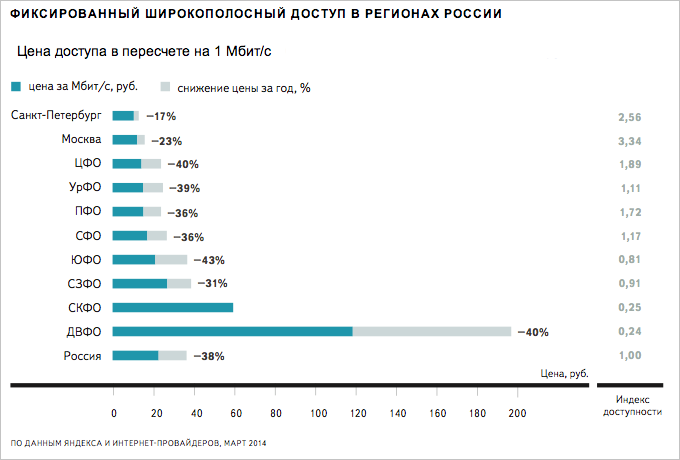

')
The study used data from Yandex.Metrica, News, Directory and Directory, as well as data on Internet penetration from the Public Opinion Foundation and on the mobile Internet audience from the TNS research group.
According to the FOM, in the fall of 2013, there are 66.5 million people over 18 in Russia who surf the Internet at least once a month - more than 57% of the total adult population of the country. Four fifths of them, more than 53 million people, use the Internet daily.
Small cities are gradually catching up with large-scale Internet penetration levels, and the differences between regions regarding accessibility to the network are being erased. Among the Internet audience, there are more and more older people.
The growth rate of the Internet audience in Russia continues to slow down. From autumn 2012 to autumn 2013, the increase in the number of users was less than 9% - this is the lowest figure in the last ten years. However, in absolute terms, the increase looks impressive - more than 5 million people. It is like the population of St. Petersburg.
The daily audience has grown even more - this means that many users who used to go to the Internet only from time to time now do it every day.
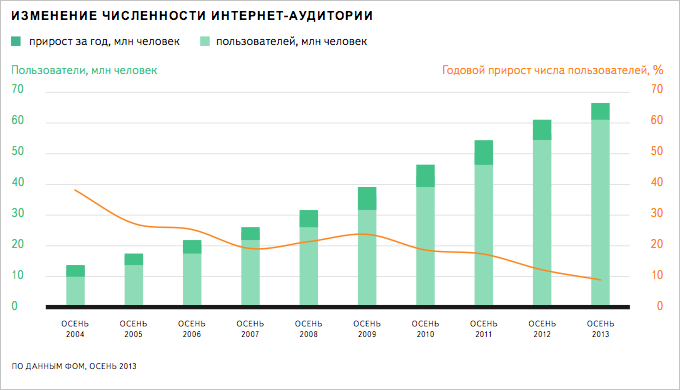
In 2013, the fastest growing Internet audience was in Siberia, the South and the North Caucasus, as well as in the central regions of Russia. The same regions most quickly caught up with the capital in terms of Internet penetration. In absolute figures, the Central District showed the largest audience growth.
In 2013, in St. Petersburg and the Far East, the growth of the audience and the penetration of the Internet completely stopped. FOM registered a slight decrease in these indicators in both regions.


More than a third of new Internet users are from rural areas. Compared with last year, their number increased by 18%, or about 2 million people. This is the highest growth rate among all types of settlements, both in absolute and relative numbers.


Five years ago, fewer Internet users lived in all Russian villages than in Moscow alone. Today, the number of rural Internet audience is already a quarter more than in both Russian capitals combined. If in the coming years, the penetration of the Internet in rural areas will reach the current level of cities with a population of less than 100 thousand people, then there will be about 3.5 million new users.
In 2013, the daily Internet audience grew faster than the monthly. The share of users who go online every day has exceeded 80%.

Every year the Internet is used by more and more older people. Persons under 35 still account for more than half of the Internet audience in Russia, but their share is declining. Children and youth most of all among Internet users in small cities and rural areas, and older people among Muscovites.
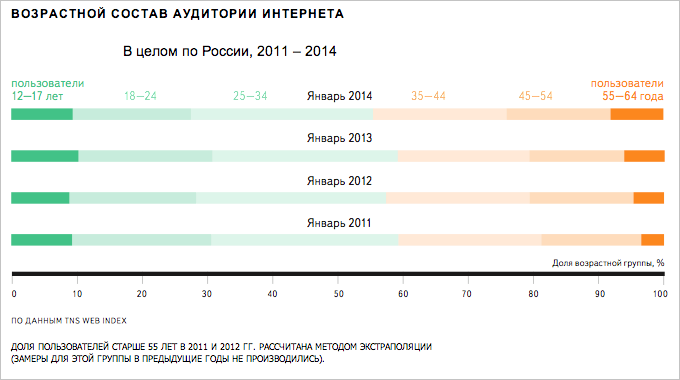

According to Yandex, in 2013 the average rate of fixed broadband access declared by providers increased, and the cost of unlimited access in terms of one Mbps decreased in all regions of Russia. Most of all, the Internet has fallen in price in the South, the Far East and in the central regions of Russia, and least of all in the capitals.
Despite the widespread decline in prices, the difference between regions in terms of price and availability of the Internet is still huge. For example, residents of the Far East pay for one Mbps almost ten times more than Muscovites. According to the accessibility index, which takes into account the income of the population, this difference is even greater - about 14 times.

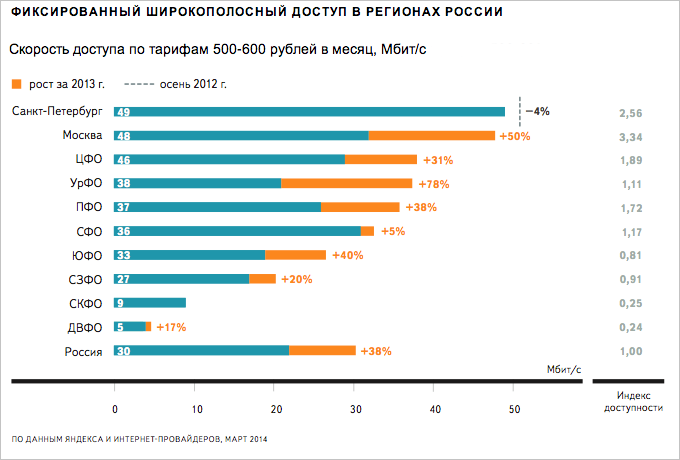
The gap between the regions on the availability of mobile Internet has noticeably narrowed - the difference in price per GB of traffic between the most expensive and cheapest regions has decreased over the year from 4.2 to 2.4 times. At the beginning of 2014, most mobile traffic without a speed limit for one salary could be bought in the Urals, and least of all in the Far East.
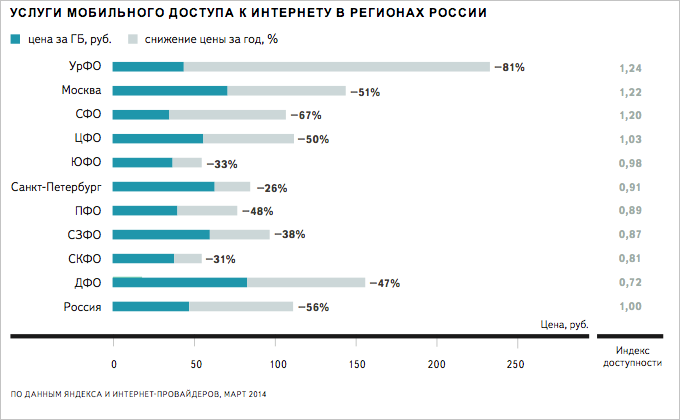
According to TNS, in December 2013, about 25.5 million residents of large Russian cities (with a population of more than 100 thousand people) took advantage of various mobile devices (phones, smartphones, tablet computers) to access the network. This is more than 40% of the population of these cities over the age of 12 years.
The number of mobile Internet audience increased in 2013 by more than one and a half times - for a record 8.7 million users. The highest increase was observed in the Urals and in Moscow, here users increased by 69% and 64%, respectively.

The penetration of mobile Internet grew at an unprecedented rate: by the end of the year, this indicator for cities with a population of more than 100 thousand increased by 14.2 percentage points, and in Moscow and St. Petersburg the growth was even stronger.
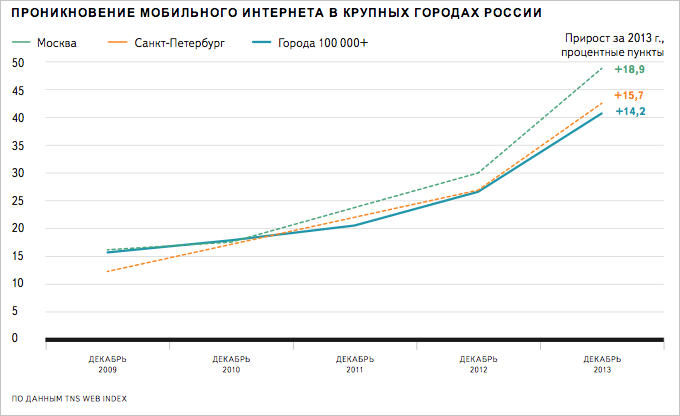
According to Yandex.Metrica as of February 2014, 86% of Russian mobile Internet users access the network from smartphones and communicators based on Android and iOS. The share of alternative platforms among mobile devices used to access the Internet in different regions did not exceed 10-20%.

According to Yandex.Metrica, residents of the economically developed regions of Russia often use the mobile Internet. Worst of all things are in regions with relatively low incomes, as well as in remote parts of the country where access infrastructure is not developed. In the capitals, mobile Internet is used 2–3 times more actively than the average in Russia. Among the regions, the first place is occupied by the Ural Federal District.
More details and graphs for each federal district of Russia on the research page .
- Over the past year, the average speed of fixed broadband access, announced by providers, increased by 38%.
- Against the background of widespread tariff reductions, a noticeable difference between regions on prices for broadband access still remains. For example, residents of the Far East pay for one Mbps almost ten times more than Muscovites. According to the accessibility index, which takes into account the income of the population, this difference is even greater - about 14 times.

- According to Yandex, the cost of one gigabyte of mobile traffic in 2013 decreased by 59%, and the difference between the regions in the affordability of mobile Internet has almost halved.
- According to Yandex.Metrica, mobile Internet is most actively used in metropolitan regions and in the Urals Federal District.
- 55% of Russian organizations registered with Yandex. Reference Book indicated that they have their own website. The highest proportion of such organizations is in the capitals and in Central Russia, but the fastest number of such organizations is growing in the North Caucasus.

')
- According to Yandex.Metrica as of February 2014, 86% of Russian mobile Internet users access the network from smartphones and communicators based on Android and iOS. The share of alternative platforms among mobile devices used to access the Internet in different regions did not exceed 10-20%.
Internet audience
The study used data from Yandex.Metrica, News, Directory and Directory, as well as data on Internet penetration from the Public Opinion Foundation and on the mobile Internet audience from the TNS research group.
According to the FOM, in the fall of 2013, there are 66.5 million people over 18 in Russia who surf the Internet at least once a month - more than 57% of the total adult population of the country. Four fifths of them, more than 53 million people, use the Internet daily.
Small cities are gradually catching up with large-scale Internet penetration levels, and the differences between regions regarding accessibility to the network are being erased. Among the Internet audience, there are more and more older people.
Internet audience growth
The growth rate of the Internet audience in Russia continues to slow down. From autumn 2012 to autumn 2013, the increase in the number of users was less than 9% - this is the lowest figure in the last ten years. However, in absolute terms, the increase looks impressive - more than 5 million people. It is like the population of St. Petersburg.
The daily audience has grown even more - this means that many users who used to go to the Internet only from time to time now do it every day.

In 2013, the fastest growing Internet audience was in Siberia, the South and the North Caucasus, as well as in the central regions of Russia. The same regions most quickly caught up with the capital in terms of Internet penetration. In absolute figures, the Central District showed the largest audience growth.
In 2013, in St. Petersburg and the Far East, the growth of the audience and the penetration of the Internet completely stopped. FOM registered a slight decrease in these indicators in both regions.


More than a third of new Internet users are from rural areas. Compared with last year, their number increased by 18%, or about 2 million people. This is the highest growth rate among all types of settlements, both in absolute and relative numbers.


Five years ago, fewer Internet users lived in all Russian villages than in Moscow alone. Today, the number of rural Internet audience is already a quarter more than in both Russian capitals combined. If in the coming years, the penetration of the Internet in rural areas will reach the current level of cities with a population of less than 100 thousand people, then there will be about 3.5 million new users.
Changing the composition of the Internet audience
In 2013, the daily Internet audience grew faster than the monthly. The share of users who go online every day has exceeded 80%.

Every year the Internet is used by more and more older people. Persons under 35 still account for more than half of the Internet audience in Russia, but their share is declining. Children and youth most of all among Internet users in small cities and rural areas, and older people among Muscovites.


Internet access
Fixed broadband access
According to Yandex, in 2013 the average rate of fixed broadband access declared by providers increased, and the cost of unlimited access in terms of one Mbps decreased in all regions of Russia. Most of all, the Internet has fallen in price in the South, the Far East and in the central regions of Russia, and least of all in the capitals.
Despite the widespread decline in prices, the difference between regions in terms of price and availability of the Internet is still huge. For example, residents of the Far East pay for one Mbps almost ten times more than Muscovites. According to the accessibility index, which takes into account the income of the population, this difference is even greater - about 14 times.
What is a fixed internet availability index?
The index of the availability of a fixed Internet shows how many times the connection speed of a resident of a region and an average Russian will vary, provided that they spend the same part of their salary on this service. The calculation used data on the average salary accrued by the State Statistics Committee of Russia for January 2014.


Mobile access
The gap between the regions on the availability of mobile Internet has noticeably narrowed - the difference in price per GB of traffic between the most expensive and cheapest regions has decreased over the year from 4.2 to 2.4 times. At the beginning of 2014, most mobile traffic without a speed limit for one salary could be bought in the Urals, and least of all in the Far East.
What is the Mobile Internet Accessibility Index?
The Mobile Internet Accessibility Index shows how many times the traffic volume will vary with no speed limit for a resident of the region and an average Russian, provided that they spend the same part of their salary on this service. The calculation used data on the average salary accrued by the State Statistics Committee of Russia for January 2014.

Mobile Internet
Lecture hall
According to TNS, in December 2013, about 25.5 million residents of large Russian cities (with a population of more than 100 thousand people) took advantage of various mobile devices (phones, smartphones, tablet computers) to access the network. This is more than 40% of the population of these cities over the age of 12 years.
About TNS
It takes into account only residents of Russian cities with a population of more than 100 thousand people aged 12 years and older. Therefore, TNS data on the audience and mobile Internet penetration cannot be compared with the Public Opinion Foundation data on the fixed Internet.
The number of mobile Internet audience increased in 2013 by more than one and a half times - for a record 8.7 million users. The highest increase was observed in the Urals and in Moscow, here users increased by 69% and 64%, respectively.

The penetration of mobile Internet grew at an unprecedented rate: by the end of the year, this indicator for cities with a population of more than 100 thousand increased by 14.2 percentage points, and in Moscow and St. Petersburg the growth was even stronger.

Devices
According to Yandex.Metrica as of February 2014, 86% of Russian mobile Internet users access the network from smartphones and communicators based on Android and iOS. The share of alternative platforms among mobile devices used to access the Internet in different regions did not exceed 10-20%.

According to Yandex.Metrica, residents of the economically developed regions of Russia often use the mobile Internet. Worst of all things are in regions with relatively low incomes, as well as in remote parts of the country where access infrastructure is not developed. In the capitals, mobile Internet is used 2–3 times more actively than the average in Russia. Among the regions, the first place is occupied by the Ural Federal District.
How was the assessment made?
The assessment was made on the basis of the activity index of the use of the mobile Internet - an indicator illustrating how many times more people use the Internet from mobile devices in this region than in Russia on average.
More details and graphs for each federal district of Russia on the research page .
Source: https://habr.com/ru/post/218899/
All Articles